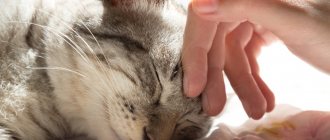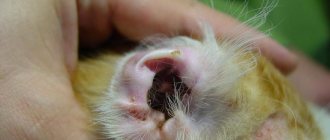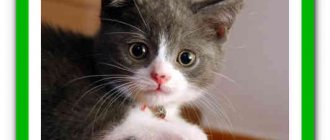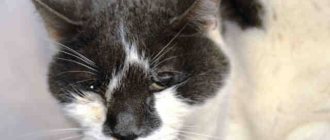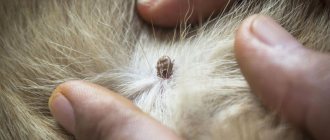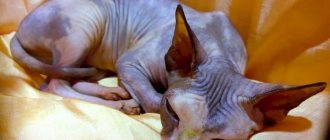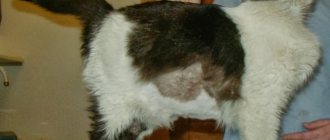People take colds so lightly that when they get sick, they don’t even stop working, infecting healthy people in transport and colleagues at work. In the modern pace of life, it is not customary to take sick leave or reschedule plans. Our pets live differently, but they get sick like us. A cold in cats is not a fatal disease, but it poses a greater danger than the familiar human acute respiratory infection.
Causes of the disease
The disease can occur for a number of reasons, including:
- Improper maintenance of a mustachioed pet. A cat can become hypothermic while outside or on a balcony; catch a cold due to drafts moving around the room; “earn” a runny nose if the hair remains wet after washing.
- Viral infection. Pets can become ill by contracting the disease from sick street animals.
Incorrectly selected food, lack of proper care, and the presence of chronic illnesses weaken the body’s immune system; weakened immunity contributes to the development of colds.
If the owner is confident that the animal is being kept properly and there are symptoms of the disease, then it is necessary to treat the animal for a viral infection.
Veterinarians call the disease “rinotracheitis”, it refers to complex diseases, the causative agent is a virus located in the external environment, found in the urine, feces, and secretions of a sick individual. Can be transmitted through direct contact by airborne droplets.
A cat that doesn't go outside can still become infected. The pathogen can enter the apartment by ending up on the owner’s street shoes or clothes.
Why does a cat get a cold?
Many animal lovers wonder whether cats get colds. A healthy animal rarely gets respiratory infections, since its immune system fights viruses well. The causes of colds include the following factors:
- Elderly age. After 10 years, the animal develops chronic diseases that weaken the body's defenses. The cat becomes vulnerable to bacterial and viral infections.
- Violation of the rules of care. High humidity and low indoor air temperature are the most common causes of colds in cats.
- Poor nutrition. The state of immunity is negatively affected by vitamin deficiency, which occurs when low-quality or monotonous foods are included in the diet.
- Sudden change in temperature. Cats react acutely to changes in temperature in the house. During the warm season, you should not turn on the air conditioner in the room where your pet lives. Hypothermia often occurs in cats that have access to the street. Wet wool disrupts thermoregulation. The animal freezes within a few minutes, especially in windy weather. The cause of the disease can also be poor drying of the coat after bathing.
- Chronic diseases, malignant tumors. These pathologies reduce the body's defenses, which is why a cat can catch a cold from a person.
Symptoms
The clinical picture of a viral infection and a cold is easy to confuse; the symptoms are almost the same.
Sick beast:
- feels weak, constantly lies down, stops playing;
- loses interest in his surroundings;
- practically stops eating;
- has difficulty breathing;
- begins to cough, sneeze;
- discharge appears from the sinuses;
- lacrimation is observed;
- the nasal mucosa becomes hot and dry;
- body temperature rises.
Be sure to read:
Calicivirus infection in cats: treatment at home + VIDEO recommendations
The clinical picture of a viral infection can be complemented by the following signs:
- the lymph nodes located under the jaw increase in size;
- the nasal sinuses become covered with a white coating;
- the cat has difficulty eating and drinking water;
- Ulcers form on the mucous membranes of the lips, tongue, and eyes.
Symptoms of a cold in a cat
The disease affects the eyes, respiratory organs and nasal mucous membranes. Signs of a cold in a cat are as follows:
- Dryness and change in temperature of the nose.
- Signs of body intoxication. The cat becomes weak and lethargic, she refuses food and games. With a mild to moderate cold, the cat easily rises from the bed and stands confidently on its paws. A severe course of the disease is indicated by severe weakness, in which the animal prefers to lie down constantly.
- Runny nose. The fact that the cat has caught a cold is indicated by difficulty breathing and the appearance of clear, thick discharge from the nose. A sick pet breathes through its mouth, which contributes to drying out of the mucous membranes. The animal begins to drink water more often. The cat's mouth is constantly open. If the nasal discharge becomes yellow or greenish in color, it is a sign of a bacterial infection.
- Coughing and sneezing. These signs indicate the launch of protective mechanisms aimed at clearing the respiratory tract of mucus. Coughing and sneezing during a cold is considered normal. In this case, a light coating may appear on the cat’s lip. Severe contamination of fur in the nose and mouth area indicates the presence of more dangerous diseases.
- Inflammation of the mucous membranes of the eyes. Accompanied by photophobia and lacrimation.
- Decreased appetite. The cat may refuse food for several days, while it drinks large amounts of liquid. It is not worth forcing the animal to eat; if the appetite does not return after 3 days, contact a veterinarian.
- Increased body temperature.
The cat has a cold and is sneezing: what to do?
If your pet is sneezing, coughing, the nose is dry and hot, the eyes are watery, there is no appetite, breathing is difficult, you should give the cat first aid.
Algorithm of actions:
- Carry out a visual inspection, analyze whether the disease is the result of a viral infection.
- Place the sick person in a comfortable, warm place, making sure there are no drafts.
- Put a heating pad on if the animal is cold.
- Give plenty of warm water and milk. Cold drinks are prohibited.
- Massage your body to increase blood circulation.
- Offer nutritious food.
If after two or three days the pet’s condition remains unchanged, you must visit a veterinary clinic, where the doctor will make an accurate diagnosis.
Prevention
A cat may develop colds if it has a heat exchange disorder. In its normal state, a layer of air forms in its undercoat, something like a “thermos”, which reliably protects it from colds and prevents heat loss. When it gets wet, the “thermos” does not work, and the cat begins to freeze, at which time she becomes most vulnerable to drafts. If a cat comes home cold and wet after going outside, then the first thing to do is to provide him with warmth and quickly dry the animal.
The kitten must be protected during bathing, provided with the water temperature necessary for its body, and a warm towel. It must be remembered that the water temperature that is pleasant for bathing people will be low for cats. The most acceptable water temperature for bathing mustaches is 39-40 degrees. After bathing, the cat must be wrapped in a warm towel prepared in advance and pressed against your arms. This way the pet will calm down and warm up better.
If your cat gets a cold during a walk and does not recover with home remedies, then you need to contact a veterinarian as soon as possible. It will help cure a sick animal.
How to treat at home
A calm course of the disease requires treatment at home.
A number of activities should be included in therapy:
- Provide coziness and comfort.
- Ease your general condition.
- Relieve symptoms.
- Stop further development of the disease.
Before starting drug therapy, you should monitor the body's reaction; perhaps the animal will recover without medication.
It is useful to include inhalations based on eucalyptus oil and eucalyptus leaves in therapy.
The procedure is carried out as follows:
- Prepare a decoction from the leaves of the plant, place a hot pan indoors (bathroom).
- Wrap the animal in a terry towel so that the cat cannot resist.
- Move your muzzle to the pan with healing steam.
- Make sure that the animal does not get burned.
- Do inhalation for 10-15 minutes, 2 times a day.
The eyes and nasal passages are washed with warm water to relieve the general condition.
Treatment of frostbite
Warm frostbitten areas by immersing them in warm (not hot) water for 20 minutes, or until the tissue turns red. Never use snow or ice. Tissue damage increases significantly if thawing is followed by freezing. Do not rub or massage the affected parts because the damaged tissue is easily destroyed. Your cat should see a veterinarian as soon as possible. Antibacterial therapy may be prescribed to prevent secondary infections.
Once sensation returns to the frostbitten areas, the cat may experience pain. Don't let your cat over-groom or lick these areas.
Treating cat colds with medications
Treatment of the animal is carried out at home, after consulting with a veterinarian. It is difficult to give medications in tablet form to cats because of the bitter taste.
It is forbidden to give antipyretic drugs (aspirin, paracetamol) to cats due to the toxic effects on the animal’s body.
To reduce the temperature, use a cool, damp compress, which is placed on the animal’s head.
Be sure to read:
How to identify rabies in a cat at an early stage, the first signs
. Copious liquid discharge from the nasal sinuses is stopped with the help of nasal drops, which are prescribed to a person. A runny nose can be relieved by Nazivin and Xylometazoline. 1 drop in each nasal passage 2 times a day.
Only a veterinarian can prescribe antibacterial agents (antibiotics); the doctor will recommend the drug and determine the dose.
A sick cat is prescribed drugs of the tetracycline group. The medication is taken 2 times a day.
Drugs for treatment:
- "Ampicillin"
- "Streptomycin",
- "Tetracycline"
- "Amoxicillin"
- “clindamycin”
When treating colds, Interferon and Immunoglobulin are used in injections.
To strengthen the immune system, injections of B vitamins are recommended.
What to do if your cat has a cold
If your cat exhibits cold symptoms: runny nose and cough, watery eyes, dry nose, and is lethargic and does not eat well, it is recommended to go to the veterinary clinic. Laboratory tests may be needed to make an accurate diagnosis.
Important! In the case of animals, you cannot self-medicate, because human medications and human dosages are not suitable for them.
Timely comprehensive vaccinations can protect the animal from a number of viral diseases. And for bacterial infections, antibiotics are prescribed, which must be taken on schedule. For any illness, infected cats are prescribed complex therapy, which includes symptomatic treatment and restorative medications that help the animal overcome the disease faster.
Colds are dangerous for cats because if help is not provided in time, it can cause the death of the animal.
During treatment, you must follow the general rules:
- Do not allow the animal to become dehydrated, so the water bowl should be constantly filled.
- When sick, kittens may experience discharge from the nose and eyes. It is necessary to wash your pet regularly and carefully wipe away any secretions with a damp cloth.
- A sick cat usually has a poor appetite, but he needs to eat to maintain vitality. Familiar food can be slightly warmed up to make it smell stronger and arouse your pet's interest. You can also offer a sick cat something tasty and new. To make the food easier to eat and swallow, it can be diluted with water.
Cat colds are not dangerous for the owner, so the question of whether you can get a cold or flu from a cat should not arise. However, they can cause infection to other pets if they live in the same room. A sick animal needs to be isolated; a week is usually enough to treat a cold.
Possible consequences of a cold
It can be difficult for cat owners to understand that the disease is not typical for a small predator, and the complications, if left untreated, are extremely dangerous. A cat's illness rarely poses a danger to the human body, but can be transmitted to other four-legged and feathered inhabitants of the apartment.
If you ignore the primary symptoms and do not start treatment in time, the disease progresses to a serious stage.
Typical complications:
- bronchitis,
- pneumonia,
- joint damage,
- genitourinary infections.
Also, an immune system weakened by illness is a poor “protector” for the animal. Viruses brought by the owner on street clothes and shoes can easily infect a sick body.
Can a cat infect a person with rhinotracheitis?
According to the veterinarian, rhinotracheitis is strictly a specific disease of cats. Therefore, they cannot infect humans or other pets, such as dogs or hamsters, with it.
A cat can only become infected through contact with a sick animal. “If the animal is domestic and has no contact with other cats, it has no risk of becoming infected. But it happens that owners pick up an unfortunate “crying” kitten on the street and bring it home, and as a result, the domestic cat begins to get sick with everything that the kitten brought from the street. In addition, there are animals that can be carriers of the virus, but it can manifest itself clinically in them,” explains Solovyova.
Also, the pet runs the risk of contracting herpes if the owners rent it out to a cat hotel for a while. “Bringing animals into a cat hotel without a passport is fraught with problems. If maintenance and hygiene standards are not observed there, theoretically, the animal can get sick. But, as a rule, such establishments accept animals with vaccination or they are injected with a prophylactic serum, which works for 15 days. This is passive immunity during the stay in the hotel,” says the veterinarian.
Cat and mouse. Can a pet eat caught birds and rodents? More details
Drug therapy
If your kitten's cold does not go away with home treatment, then you should visit a doctor. He will check the animal and prescribe appropriate treatment. The treatment plan includes taking medications, which must be done exclusively according to the instructions of a specialist.
The veterinarian usually prescribes the following remedies if the cat has a cold:
- Antipyretic medications if you have a fever.
- Expectorants for wheezing.
- Drugs that destroy pathogenic microorganisms.
- Medicines that help normalize immune function.
- Vitamins.
Antibiotics are prescribed only if the cold is severe or is accompanied by another infectious disease. If a kitten refuses to eat water for a long time, the veterinarian may recommend giving him IV drips.
After all, a lack of water in the body is dangerous and can lead to death.
